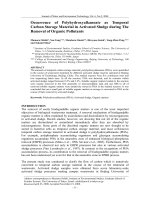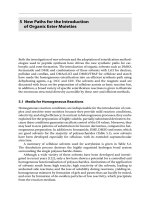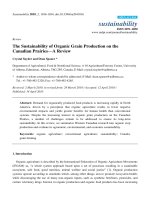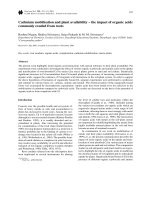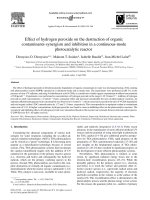the roots of organic development
Bạn đang xem bản rút gọn của tài liệu. Xem và tải ngay bản đầy đủ của tài liệu tại đây (16.25 MB, 579 trang )
Industrial Chemistry Library, Volume 8
The Roots of
Organic Development
Industrial Chemistry Library
Advisory Editor:
S.T. Sie,
Faculty of Chemical Technology and Materials Science
Delft University of Technology, Delft, The Netherlands
Volume 1
Volume 2
Volume 3
Volume 4
Volume 5
Volume 6
Volume 7
Volume 8
Progress in C1 Chemistry in Japan
(Edited by the Research Association for C 1 Chemistry)
Calcium Magnesium Acetate. An Emerging Bulk Chemical for
Environmental Applications
(Edited by D.L. Wise, Y.A. Levendis and M. Metghalchi)
Advances in Organobromine Chemistry I
(Edited by J R. Desmurs and B. Gdrard)
Technology of Corn Wet Milling and Associated Processes
(by P.H. Blanchard)
Lithium Batteries. New Materials, Developments and Perspectives
(Edited by G. Pistoia)
Industrial Chemicals. Their Characteristics and Development
(by G. Again)
Advances in Organobromine Chemistry II
(Edited by J R. Desmurs, B. Gdrard and M.J. Goldstein)
The Roots of Organic Development
(Edited by J R. Desmurs and S. Ratton)
Industrial Chemistry Library, Volume 8
The Roots of Organic
Development
Edited by
Jean-Roger
Desmurs
Rh6ne Poulenc Industrialisation, CRIT/Carrikres, 85 Avenue des Frbres Perret,
69192 Saint-Fons Cedex, France
Serge Ratton
Rh6ne Poulenc Organic Intermediates Enterprise, 25 Quai Paul Doumer,
92408 Courbevoie Cedex, France
1996
ELSEVIER
Amsterdam ~ Lausanne ~ New York Oxford Shannon ~ Tokyo
ELSEVlER SCIENCE B.V.
Sara Burgerhartstraat 25
P.O. Box 211, 1000 AE Amsterdam, The Netherlands
ISBN: 0-444-82434-0
9 1996 Elsevier Science B.V. All rights reserved.
No part of this publication may be reproduced, stored in a retrieval system or transmitted in
any form or by any means, electronic, mechanical, photocopying, recording or otherwise,
without the prior written permission of the publisher, Elsevier Science B.V., Copyright &
Permissions Department, P.O. Box 521, 1000 AM Amsterdam, The Netherlands.
Special regulations for readers in the USA - This publication has been registered with
the Copyright Clearance Center Inc. (CCC), Salem, Massachusetts. Information can be
obtained from the CCC about conditions under which photocopies of parts of this publica-
tion may be made in the USA. All other copyright questions, including photocopying outs-
ide of the USA, should be referred to the copyright owner, Elsevier Science B.V., unless
otherwise specified.
No responsibility is assumed by the publisher for any injury and/or damage to persons or
property as a matter of products liability, negligence or otherwise, or from any use or
operation of any methods, products, instructions or ideas contained in the material herein.
This book is printed on acid-free paper.
Printed in The Netherlands
FOREWORD
It is our belief within RHONE-POULENC that the key to building long term
customer relationship in our industry is superior technology backed up by
outstanding service.
Benefits of superior technology in Organic Chemistry are multiple : lower cost
raw materials, shorter synthesis routes, improved yields, selectivity and kinetics,
resulting in better productivity. Higher transformation rates of less hazardous
materials leads to healthier, cleaner operations with reduced waste disposal issues.
Last but not least, process safety is continually upgraded as more intimate
knowledge of chemical reactions and other unit operations is achieved.
For our worldwide customers such technical progress creates multifaceted
value: reliability, shorter response time, more competitive economics, improved
quality leading to faster registration, and safer and more environmentally
responsible operations. Furthermore, it enables us to extend the use of this expertise
to the adaptation of decisive physical or chemical properties of molecules to provide
our customers with desired use properties.
Making our overall skills available to customers to solve their problems is
indeed the basis of our ,, Chimie Nouvelle ,, approach.
In this spirit we expect and look forward to provide, along with our Organic
Intermediates technology, whatever services are required to make our joint success
complete : efficient pilot facilities, advanced analytical equipment with expert staff,
toxicology and eco toxicology support, environmental services, formulation
capabilities, we do this throughout the world.
This is the way we aim to become your preferred partner in organic chemistry,
to gain your confidence and be able to participate early in your most important
projects.
May this book demonstrate to all our existing or potential partners our
commitment to top level organic chemistry.
We are proud of the achievements and expertise of our teams. May our partners
keep challenging them to build leaderships together.
Bertrand LOUVET
Rh6ne-Poulenc Chemical Sector
Executive vice-President
Ted ZIEMANN
President of Rh6ne-Poulenc
Organic Intermediates Enterprise
This Page Intentionally Left Blank
PREFACE
It seems to us, symbolic, important, and above all promising for the furore, that
the year in which Rh6ne-Poulenc holds its centenary celebrations also sees the
publication of a scientific review, gathering together organic chemistry research
carried out in common by groups from universities and other large organisations,
and with Rh6ne-Poulenc research workers.
The development of an industrial group, especially one such as Rh6ne-Poulenc,
is directly linked to the possibility of innovation.
For this, it is necessary to rely, not just on the groups own resources and
strengths, but also on the research and discoveries made by external research
bodies.
The General Management of the Group, as far back as 1974, was aware of this
need to have a closer association with upstream research, and so signed the first
contract with the CNRS (National Research Centre).
This was only the first step, although an important one, and several years passed
before Rh6ne-Poulenc opened its research doors to the outside world. From 1981
until the present day, with the support and constant incitement of the Group
managers, a network of collaborators has been set up, at first in France, and then
abroad. This has required, from everyone involved, efforts regarding mutual
understanding, always within a climate of trust.
The first organised meetings were RP-CNRS symposia based on themes, and
focusing on problems directly related to the Groups chemical interests
(homogeneous catalysis, chemical reactivity, regioselectivity ) during which our
research workers and those of the CNRS exchanged information and results and
initiated future collaborations. Today these symposia have been replaced by
,, Journ6es RP-CNRS ,, where several themes are examined over a two day period,
using a format akin to a seminar.
It was then decided to modify these <, Journ6es Scientifiques ,,, originally
reserved for Rh6ne-Poulenc research workers, by orienting them towards a
particular theme (silicon chemistry, reactivity in organic chemistry, materials
science, molecular biology, etc.) and by inviting, under the presidency of an
internationaly renowned scientist, not only Rh6ne-Poulenc research workers, but
also the best specialists from France and abroad, interested in the theme under
examination, and by asking them to actively participate through written or oral
presentations.
VII
The assessment of these ~ Journ6es ,, has been particularly positive, allowing on
the one hand high-level research workers to discover our own research interests,
and on the other, allowing the Group to take advantage of their expertise and to
possibly have future Rh6ne-Poulenc scientists trained in their laboratories.
At pratically the same time, Rh6ne-Poulenc set up a Scientific Council,
assembling internationally renowned scientists, each working in the different areas
of research relevant to the Group.
The role of this council is essentially to provide ideas and propositions
concerning the great scientific problems, as well as an external and independant
audit, ready at any moment to notify the General and Scientific Management of any
new discoveries or advances likely to modify the direction of our research.
In 1987, the organisation of the Scientific Management was improved, with
directors being nominated for the following three areas : chemistry (J.M. Lehn),
physical-chemistry (P.G. De Gennes) and biology (C. H616ne), each being assisted
by an internal consultant, establishing permanently the opening of our research to
the external scientific world.
Today, always with this same preoccupation, under the impetus of Philippe
Desmarescaux, General Manager, and of Claude H616ne, now Scientific Director,
this collaboration has culminated in the Bio-Avenir programme, which represents a
model for the interaction between public research and industry.
But let us return to the various themes presented in this book. They represent an
image, albeit a rather incomplete one ; but an image which exemplifies this research
in common, and of the results achieved by such a methodology.
It must also be noted that everything which has just been evoked, has only been
possible because of the enthusiasm, support, trust and the willingness to persevere,
of all the research workers concerned, whatever their affiliation.
Also, it must be added that the management of the large organisations, in
particular the Management of the Chemical Sector of the CNRS, the Research
Directors of our sectors as well as the group leaders of our Research Centres, have
all contributed to this development through their encouragement and financial aid.
This continuing exciting adventure is a long term exercise. Mutual respect,
esteem and the desire to work together does not come over night. Time is needed in
order to know one another, to ~ tame one another ,, as the fox in the ~, Little Prince ,,
by Saim-Exup6ry said.
It is also important, as we have seen, to allow enough time to set up high level
competences in new areas, by accepting the failures which arrive at the start,
perseverance often bringing about the sought after results, especially in the case of
difficult scientific hurdles.
VIII
Today this long term policy is bearing fruit.
We wish that this book be the first of many in the area of chemistry and perhaps
in other areas as well.
Thank you, once again, to all those who made what was once only a wish,
become a daily reality.
C. JEANMART
Correspondant Member of
the Academy of Sciences
J.M. LEHN
Nobel Prize Winner
Presidem of the Sciemific Council
IX
ACKNOWLEDGEMENTS
We would like to thank the Rh6ne-Poulenc Organic Intermediates Enterprise for
the financial backing that has enabled this book to be published, and especially Ted
Ziemann, president of Rh6ne-Poulenc Organic Intermediates Enterprise.
We would also like to thank :
-Mrs Th6r6se Fessetaud who co-ordinated all the authors and the company
Proman.
-The Mrs Marthe Di Rollo, Dominique Trouillet, Laurence Ouled and Elisabeth
Di Rollo from Proman who did all the typing for this work.
- Mrs Tavernier for her help in translating various articles.
-The
Mrs St6fanie de Rouville and Martine Pinard from the communications
management of the chemicals sector for their help and advice.
Lastly, we would like to thank all the authors for their work that enabled the
publication of this book.
Jean-Roger DESMURS
Serge RATTON
CONTENTS
FOREWORD
B. Louvet, T. Ziemann, . V
PREFACE
C. Jeanmart, J.M. Lehn VII
ACKNOWLEDGEMENTS X
INTRODUCTION
J.R. Desmurs, C. H61~ne, D. Michelet, S. Ratton
1
SYNTHESIS
ACYLATION
Friedel-Crafts acylation : interactions between Lewis acids / acyl chlorides and
Lewis acids / aryl ketones
R. Ashforth, J.R. Desmurs 3
Bismuth (III) salts in the Friedel-Crafts acylation
J.R. Desmurs, M. Labrouill6re, J. Dubac, A. Laporterie,
H. Gaspard, F. Metz 15
Friedel-Crafts acylation of aromatics using zeolites
M. Spagnol, L. Gilbert, D. Alby 29
COC12 catalyzed trifluoroacetylation of aromatics using trifluoroacetic anhydride
J. Ruiz, L. Gilbert, D. Astruc 39
XI
ALKYLATION
Catalysis by rare earth phosphate II 9 Selective O-methylation of phenols by
methanol in vapor phase
L. Gilbert, M. Janin, A.M. Le Govic, P. Pommier, A. Aubry 48
Catalysis by rare earth phosphate III : Characterisation of samarium phosphate and
samarium phosphate-cesium hydrogenophosphate as key catalysts for O-alkylation
of phenols
A.M. Le Govic, P. Pommier, A. Aubry, L. Gilbert, M. Janin 62
AROMATIC FUNCTIONALISATION
Selective functionalisation of fluoroaromatics via organosilicon intermediates
B. Bennetau, P. Babin, J. Dunogues 75
Arylation of amines and alcohols catalyzed by nickel, copper or palladium
complexes
H.J. Cristau, J.R. Desmurs, S. Ratton,
S. Rignol, M. Taillefer 90
The isomerisation of 1,2,4-trichlorobenzene : a theoretical study
S. Firkins
107
CARBOXYLATION
Carboxylation of hydroxy aromatic compounds
I. Bonneau-Gubelmann, M. Michel, B. Besson,
S. Ratton, J.R. Desmurs 116
CHLORINATION
Access to polychlorophenols, chemistry of intermediates
J.R. Desmurs, S. Ratton, R. Jacquerot, J. Dananch6,
B. Besson, J.C. Leblanc 129
XII
Diastereoselective halogenations
P. Duhamel 176
ENZYMATIC CATALYSIS
Enzymatic hydrolysis of adiponitrile into 5-cyanovaleric acid, an intermediate for
Nylon 6
E. Cerbelaud, M.C. Bontoux, F. Foray, D. Faucher,
S. Levy-Schil, D. Thibaut, F. Soubrier, J. Crouzet, D. P6tr6 189
FLUORINATION
Reagents with trifluoromethyl substituents
H.G. Viehe, Z. Janousek 201
Fluorination of aromatic compounds by halogen exchange with fluoride anions
(,, Halex ,, reaction)
B. Langlois, L. Gilbert, G. Forat 244
4-Fluorophenol : a key intermediate for agrochemicals and pharmaceuticals
C. Mercier, P. Youmans 293
Fluorodecarboxylation of arylchloroformate : a new access to fluoroaromatics
H. Garcia, L. Gilbert, M.C. Perrod, S. Ratton, C. Rochin 301
Mild trifluoromethylation of organic compounds
C. Wakselman, M. Tordeux 313
FORMYLATION
Formylation of aromatic compounds in superacidic medium
L. Saint-Jalmes, C. Rochin, R. Janin, M. Morel 325
XIII
HYDROGENATION
High selectivities in hydrogenation of halogenonitrobenzenes on Pd, Pt or Raney
Nickel as catalysts
G. Cordier, J.M. Grosselin, R.M. Ferrero 336
HYDROXYALKYLATION
Influence of the cation in condensation of glyoxylic acid on phenols in aqueous
hydroxide solution
M.F. Wuthrick, C. Maliverney 343
HYDROXYLATION
Selective access to hydroquinone ,, Fuchsone ,, route
M. Costantini, E. Fache, D. Michelet, D. Manaut 350
NITRATION
The mechanisms of nitration of phenol
P. M6tivier, T. Schlama 368
OXIDATION
Oxidation of alkylphenols to hydroxybenzaldehydes
E. Fache, D. Laucher, M. Costantini, M. Beclere,
G. Perrin-Janet 380
Large pore Ti-Beta zeolite with very low aluminium comem : an active and
selective catalyst for oxidations using hydrogen peroxide
M.A. Camblor, M. Costantini, A. Corma, P. Esteve, L. Gilbert,
A. Martinez, S. Valencia 391
XIV
PEPTIDE SYNTHESIS
Peptide synthesis by SAPPHO technology
J.M. Bernard, K. Bouzid, J.P. Casati, M. Galvez,
C. Gervais, P. Meilland, V. P6v6re, M.F. Vandewalle,
J.P. Badey, J.M. Enderlin 405
A new and practical removal of allyl and allyloxycarbonyl group promoted by
water-soluble Pd(0) catalysts
S. Lemaire-Audoire, M. Savignac, J.P. Genet, J.M. Bernard 416
SAFETY
Safety of chlorination reactions
J.L. Gustin, A. Fines 431
APPLICATIONS
Sodium amide in organic synthesis
J.M. Poirier 445
Delivery systems for controlled release of active materials
C. Prud'homme 469
Anisole : an excellent solvent
J.R. Desmurs, S. Ratton 481
The use of phenolic compounds as free-radical polymerization inhibitors
F. Lartigue-Peyrou 489
ANALYSIS
Tracing back the origin of vanillin by SNIF-NMR
G.J. Martin 506
XV
NMR under high gas pressure
F. Metz, M. Lanson, A. Merbarch, U. Frey 528
Lactic derivatives : methods for determining the optical purity of various
intermediates
F. Marcenac, D. Bernard, F. Boyer, J. Chabannes,
Y. Danion, M. Minfray, N. Peyre, E. Zandanel, M. Hillairet,
J.C. Marsault, E. Pilot 536
AUTHOR INDEX
550
SUBJECT INDEX 552
XVI
INTRODUCTION
JEAN-ROGER DESMURS a)
AND SERGE RATTON c~
, CLAUDE
HELENE
b), DANIEL MICHELET
b)
a) Rh6ne-Poulenc Industrialisation, Centre de Recherche, d'Ing6nierie et de
Technologie, 85 Avenue des Fr~res Perret, 69192 Saint-Fons Cedex, France.
b) Direction Scientifique, 25 Quai Paul Doumer, 92408 Courbevoie Cedex,
France.
c) Interm6diaires Organiques, 25 Quai Paul Doumer, 92408 Courbevoie Cedex,
France.
This book is a collection of papers dealing with various aspects of inorganic
chemistry:
- from exploratory work on the reactivity and selectivity of new reactions to studies
on the reaction mechanisms of well known reactions,
-from work highlighting the potential of certain technologies for new reactions
(bioconversion, organometallic catalysis, etc.), to studies illustrating the potential
for synthesis of certain reactants (e.g. sodamide),
-from work on the choice and development of industrial synthesis pathways for
new Fine Chemical intermediates, to studies aimed at understanding chemical
phenomena linked to process Safety,
-
from work dealing with the treatment and formation of organic solids in order to
tailor their properties, to development of analytical techniques enabling detection of
the origin of products,
- and work on the development of new analytical methods in order to provide better
characterisation of reaction processes and products.
The diversity of topics covered in this book clearly shows the scope required
nowadays, in terms of fields of knowledge and expertise, to enable the development
of new processes and to the industrialisation and commercialisation of new
intermediates.
The speed with which the complex new process or product development
procedure must take place, starting from exploratory research right through to the
launch of the industrial production process, implies the contribution of numerous
scientific disciplines, in other words the existence of major centres of competency,
as well as perfect harmony between all the experts involved.
The major centres of competency in Organic Chemistry, the foundation of
Rh6ne-Poulenc Group Chemicals Sector's technical activity, are the fruit of many
years of basic research.
This type of research is often initiated by Rh6ne-Poulenc Group's Sciemific
Direction or benefits from its support before being fully taken over by the
Chemicals sector for confirmation of new concepts and scientific orientation
towards high potential targets.
Fundamental type research is often performed in association with the CNRS and
internationally renowned university laboratories.
This book contains a certain number of articles written by joint RP - University
Laboratory teams, which is a good illustration of the spirit of trust that motivates
researchers who are getting to know and appreciate one another more and more.
FRIEDEL-CRAFTS ACYLATION : INTERACTIONS BETWEEN LEWIS
ACIDS / ACYL CHLORIDES AND LEWIS ACIDS / ARYL KETONES
REBECCA ASHFORTH AND JEAN-ROGER DESMURS
Rh6ne-Poulenc Industrialisation, Centre de Recherche, d'Ing6nierie et de
Technologie, 85 Avenue des Fr6res Perret, B.P. 62, 69192 Saint-Fons Cedex,
France.
INTRODUCTION
The Friedel-Crafts acylation reaction is one of the most important in aromatic
chemistry used in particular to prepare aryl ketones (eqn. 1)
0
+ R C
R' \
C1 R'
+ HC1 (1)
The reaction is catalysed by a Lewis acid such as AIC13, FeC13, TIC14, SbC15,
NbC15, etc (refs. 1-5).
The major drawback of the Friedel-Crafts reaction lies in the need to use the
Lewis acid in stoichiometrical quantities relative to the acetone formed, which in
industrial terms poses large effluent problems.
The use of stoichiometrical quantities of Lewis acid results in the formation of a
complex at the end of the reaction between the aryl ketone formed and the Lewis
acid.
~__C/? MCln
/ u
To resolve the effluent problem, much work has been performed investigating
the conditions or catalysts that enable the Friedel-Crafts acylation to be performed
with catalytic quantities of Lewis acid.
Whilst the Friedel-Crafts acylation mechanism remains
determined (ref. 6) it is reasonable to postulate four stages.
to be accurately
The activation of acid chloride by the Lewis acid (eqn. 2).
O 0,,
//' R C ~ %'MCln
R C +
MCln "-
\ \ /
C1 CI"
(2)
The reaction of the activated acid chloride with the aromatic compound to give a
complex (eqn.3).
0 E~ MCln_
O, R~ 1
-~ + R C ~" """MCln ~
R' \cr"'" R'
(3)
The aromatisation of the complex (eqn. 4).
|
O
,.AICI3
/0 .,-MCIn
~ C,, R,,,-"" +HC1 (4)
R'
The decomplexation between the Lewis acid and the aryl ketone formed
(eqn. 5).
o
MCh
R,~
\~/ x R
R,/k / R
+ MCln
(5)
The Friedel-Crafts acylation with catalytic quantities of Lewis acid requires a
knowledge of the equilibria (2) and (5).
INTERACTIONS WITH LEWIS ACIDS OF METAL HALIDE TYPE
Complexation of acid chlorides
D.E.H. Jones and J.L. Wood (ref. 7) used infrared spectroscopy to study the
chloride complexes of acidic A1CI 3. The study of the complexation of acetyl
chloride by the various metal halides (Table 1) was performed by measuring the
variation of the vibration intensity (CO) at 1808 cm -1 .
Table 1. Complexation of acetyl chloride in equimolar mixtures of CH3COC1 and metal halides
(infrared).
Lewis acid
A1CI3
AIBr 3
All 3
SnC14
SnC12
TiC14
FeCI 3
GaC13 b)
SbC15 b)
SbCIs
NbC15 b)
% acetyl chloride a)
complexed by the Lewis acid
94
Insoluble
79
13
Insoluble
89
84
21
22
a) 0.2 M solution in CHzC12
b) Precipitation after 30 minutes
These results obtained using IR are confirmed with NMR in accordance with the
method described by G. Sartori (ref. 8) (Table 2).
Table 2. NMRS3C of acetyl chloride in equimolar mixtures of CH3COC1 and metal halides
a)
1,OM
Lewis acid
A1C13
SnC14
TIC14
~13C (C " 0)ppm
170.3
207.4
170.8
171.0
A~13C (C = 0)ppm
36.7
0.2
0.7
Solvent 9 CD2C12
NMR Bruker AMX 300
As described by G. Sartori (ref. 8), NMR shows that acetyl chloride is either
found free or in a 1"1 complex with A1C13.
Complexation of ketones
The complexation of p-methyl acetophenone 1 with various metal halides has
been determined using infrared by monitoring the change in vibration intensity (CO)
at 1683 m -1 (Table 3).
H3C~ O
Table 3. Complexation of p-4-methyl acetophenone 1 with equimolar mixtures of (1) and metal
halides.
Lewis acid
A1C13
A1Br 3
All3
SnC14
SnC12
TiC14
FeC13
GaC13 b)
SbC15 b)
SbC13
NbC15 b)
Ti(OCH(CH3)2)4
% of complexed p-methyl
acetophenone
83
85
100
82
100
100
100
100
38
100
a) 0.2 M solution in
CH2C12
b) Precipitation
All metal halides have electron deficiencies which complex the methyl
acetophenone.
The data obtained by infrared are perfectly confirmed by NMR (Table 4).
Table 4. NMR13C of 4-methyl acetophenone 1 with equimolar mixtures of 1 and metal halides.
1,0M
0,2 M
Lewis acid
A1C13
SnC14
GaC13
A1C13
A1Br3
All 3
SnC12
TIC14
FeC13
SbC15
SbC13
NbC15
~13C (C 0) ppm
197.7
A~13C (C = 0) ppm
214.9 17.2
209.3 11.6
215.3 17.6
197.9
214.6 16.7
215.4; 215.6 [ 17.5; 17.7
!
214.9 17.0
Insoluble
Precipitation
Paramagnetic
Precipitation
200.2 2.3
215.5 17.6
As opposed to acetyl chloride, we can observe a continuous change in the
chemical shift of the carbon in the carbonyl group given in Figure 1 as a function of
a varying aluminium chloride / 4-methyl benzophenone ratio.
